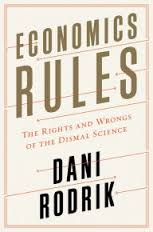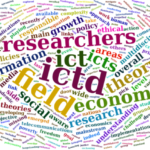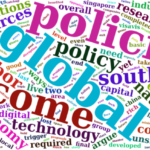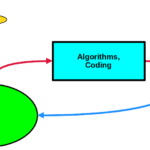After the 2008 crisis, many observers expected changes of some sort in current economic thinking and academic teaching. After all, most mainstream economists never saw the crisis coming – with some even claiming the era of crises was over. For  many non-economists, the crisis demonstrated once again the perils of economics, the “dismal science”. Eight years later we can say little has changed in economics since. Some will even argue that the current economic paradigms have in fact come back with a vengeance. The debates around austerity policies is but one example of this.
many non-economists, the crisis demonstrated once again the perils of economics, the “dismal science”. Eight years later we can say little has changed in economics since. Some will even argue that the current economic paradigms have in fact come back with a vengeance. The debates around austerity policies is but one example of this.
The new book by Rodrick can be described as an honest attempt to rescue economics from the bad place it seems to be today, especially in the eyes of non-economists. In his view for example the oversight of the 2008 crisis is an “error of omission” (pg. 157 on).
As a starting point we are informed that economics is not the science that aims at explaining how the economy works. Rather, it is a method for doing social sciences using particular tools. As we will see below this is one issue that needs to be addressed in detail, not assumed as a solid starting point.
So what is this method for doing social sciences? It is based on the use of models that become “our best cognitive guide to the endless hills and valleys that constitute social experience” (pg. 8). There is already a wide variety of models out there and more are being developed at the moment. But newer models do not detract from older ones. On the contrary, “they simply expand the range of the discipline’s insights… Older models remain useful; we add to them.” (pg. 71).
We also need to understand that models are simplified (not simplistic) representations of reality with specific assumptions used to test particular hypothesis. As long as these are clearly and openly stated, the usefulness of models increases.1 Rodrik links models to fables. This is similar to what Elinor Ostrom did in her classic book, Governing the Commons, when she linked the Tragedy of the Commons model and others to metaphors. But she also made the crucial point that metaphors are appropriated by the public and policy makers in ways that can prevent switching to other, more adequate models. The use of mathematics in modelling does not give models their unique value added. Rodrik argues that math “plays two roles in economics, neither of which causes glory: clarity and consistency” (pg. 31).
Give the plethora of models, how do we the choose the best suited model? Here we can find four “verification strategies” (pg. 93): 1. Check critical assumptions; 2. Check the functioning of the model’s internal mechanisms; 3. Check its direct implications; and 4. Check that incidental implications are consistent with observed outcomes. One key question here is the analytical framework to undertake the verification process: is this a pure logical exercise or is there a conceptual framework or theory to support it?
Rodrik seems to answer this implicit question by saying that “general economic theories are no more that a scaffolding for empirical contingencies…They are a way of organizing our thoughts, rather than stand-alone explanatory frameworks. On their own, they have little real leverage over the world” (pg. 116). Theories are not useful and our only way of doing real science is by using models. Rodrik also reinforces this point of view by arguing that unlike nature, society has no general laws. In this context theories become even less useful. Only models work here.
The other big issue is how are models created. Where do they come from? How are they built? This is an important question that is not really addressed in the book.
Given all this, it is odd that economists can go wrong so often. Rodrik argues this is the case when economist confuse “a model with the model” (pg. 152). This is compounded because economists are biased towards markets; furthermore they “are not always good about drawing the links between their models and the world” (pg. 171). Rodrik concludes: “The corrective is for economists to return to the seminar room and remind themselves of the other models in their collection” (pg. 175). We thus also need a strategy to navigate across models.
With all this in hand, the author argues that most criticisms of economics are uncalled for. While some economists are indeed arrogant and probably not open minded, this is more a result of their own behavior rather than a trait of the field. Economists should avoid value judgments by all means and explicitly say so when they do.
Certainly, Rodrik is far from being a typical mainstream economist. And the contents of this book shows that. And we shout tip our hats to the author for this. Most probably, a bunch of so-called mainstream economists will tend to disagree with some of the views and ideas presented here.
Anyways, let us go back to the initial assumption on the nature of economics. Here, we should apply Rodrik’s own “verification strategies”. This assumption makes economics the “mother” of all other social sciences. This is for sure a strong assumption. I am sure many social scientists will disagree with it. Unfortunately, the book does not explore this in depth and thus leaves a hole in the argument. Historically, a deep and complex debate on the subject has taken place for many years now, some under the heading of the “philosophy of economics”.2 Authors such as Lakatos, Cartwright, Mirowski, and Maki should be consulted in this regard. This book touches on some of these issues which, as I see it, are beyond economics.
Another issue that could probably had been developed further relates to model development. How does this happen? What are their theoretical underpinnings? Rodrik indirectly deals with this with the example of Smith “invisible hand” which later on became the First Fundamental Theorem of Welfare Economics. Certainly, Smith’s political economy approach was much broader than just markets and included analysis of production processes, the role of the state and the distribution of wealth in society.3 See for example Ebenstein, Lanny. 2015. Chicagonomics. Chapter 2. The model took one aspect of his broader theory and that became a theorem in economics. What happened to the rest? How was this choice made?
In the end, economic models have a very hard time incorporating non-economic issues such as democracy, justice or human rights, to name a few, in their design. These are not value judgment issues. In this case, we either need to have other “tools” to incorporate such issues in existing models, or we will need to define them as limited cognitive tools for broader social science practice. Theories might help here too…
Rodrick, Dani. 2015. Economic Rules: The Rights and Wrongs of the Dismal Science. New York: W.W. Norton. ISBN: 978-0-393-24641-4.
Endnotes
| ⇧1 | Rodrik links models to fables. This is similar to what Elinor Ostrom did in her classic book, Governing the Commons, when she linked the Tragedy of the Commons model and others to metaphors. But she also made the crucial point that metaphors are appropriated by the public and policy makers in ways that can prevent switching to other, more adequate models. |
|---|---|
| ⇧2 | Authors such as Lakatos, Cartwright, Mirowski, and Maki should be consulted in this regard. |
| ⇧3 | See for example Ebenstein, Lanny. 2015. Chicagonomics. Chapter 2. |







Comments
2 Responses to “Economics Rules or Economics Rule?”
New post: Economics Rules or Economics Rule? https://t.co/QIPTW0IGdj
Post Edited: Economics Rules or Economics Rule? https://t.co/QIPTW0IGdj